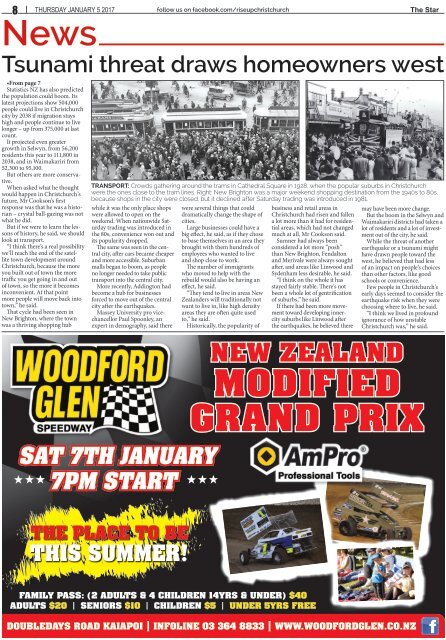The Star: January 05, 2017
You also want an ePaper? Increase the reach of your titles
YUMPU automatically turns print PDFs into web optimized ePapers that Google loves.
8<br />
Thursday <strong>January</strong> 5 <strong>2017</strong><br />
News<br />
Tsunami threat draws homeowners west<br />
•From page 7<br />
Statistics NZ has also predicted<br />
the population could boom. Its<br />
latest projections show 504,000<br />
people could live in Christchurch<br />
city by 2038 if migration stays<br />
high and people continue to live<br />
longer – up from 375,000 at last<br />
count.<br />
It projected even greater<br />
growth in Selwyn, from 56,200<br />
residents this year to 111,800 in<br />
2038, and in Waimakariri from<br />
52,300 to 95,100.<br />
But others are more conservative.<br />
When asked what he thought<br />
would happen in Christchurch’s<br />
future, Mr Cookson’s first<br />
response was that he was a historian<br />
– crystal ball-gazing was not<br />
what he did.<br />
But if we were to learn the lessons<br />
of history, he said, we should<br />
look at transport.<br />
“I think there’s a real possibility<br />
we’ll reach the end of the satellite<br />
town development around<br />
Christchurch, because the more<br />
you built out of town the more<br />
traffic you get going in and out<br />
of town, so the more it becomes<br />
inconvenient. At that point<br />
more people will move back into<br />
town,” he said.<br />
That cycle had been seen in<br />
New Brighton, where the town<br />
was a thriving shopping hub<br />
TRANSPORT: Crowds gathering around the trams in Cathedral Square in 1928, when the popular suburbs in Christchurch<br />
were the ones close to the tram lines. Right: New Brighton was a major weekend shopping destination from the 1940s to 80s,<br />
because shops in the city were closed, but it declined after Saturday trading was introduced in 1981.<br />
while it was the only place shops<br />
were allowed to open on the<br />
weekend. When nationwide Saturday<br />
trading was introduced in<br />
the 80s, convenience won out and<br />
its popularity dropped.<br />
<strong>The</strong> same was seen in the central<br />
city, after cars became cheaper<br />
and more accessible. Suburban<br />
malls began to boom, as people<br />
no longer needed to take public<br />
transport into the central city.<br />
More recently, Addington had<br />
become a hub for businesses<br />
forced to move out of the central<br />
city after the earthquakes.<br />
Massey University pro vicechancellor<br />
Paul Spoonley, an<br />
expert in demography, said there<br />
SAt 7th JAnUARY<br />
7pM StARt<br />
follow us on facebook.com/riseupchristchurch<br />
were several things that could<br />
dramatically change the shape of<br />
cities.<br />
Large businesses could have a<br />
big effect, he said, as if they chose<br />
to base themselves in an area they<br />
brought with them hundreds of<br />
employees who wanted to live<br />
and shop close to work.<br />
<strong>The</strong> number of immigrants<br />
who moved to help with the<br />
rebuild would also be having an<br />
effect, he said.<br />
“<strong>The</strong>y tend to live in areas New<br />
Zealanders will traditionally not<br />
want to live in, like high density<br />
areas they are often quite used<br />
to,” he said.<br />
Historically, the popularity of<br />
business and retail areas in<br />
Christchurch had risen and fallen<br />
a lot more than it had for residential<br />
areas, which had not changed<br />
much at all, Mr Cookson said.<br />
Sumner had always been<br />
considered a lot more “posh”<br />
than New Brighton, Fendalton<br />
and Merivale were always sought<br />
after, and areas like Linwood and<br />
Sydenham less desirable, he said.<br />
“I think on the whole it has<br />
stayed fairly stable. <strong>The</strong>re’s not<br />
been a whole lot of gentrification<br />
of suburbs,” he said.<br />
If there had been more movement<br />
toward developing innercity<br />
suburbs like Linwood after<br />
the earthquakes, he believed there<br />
<strong>The</strong> <strong>Star</strong><br />
may have been more change.<br />
But the boom in the Selwyn and<br />
Waimakariri districts had taken a<br />
lot of residents and a lot of investment<br />
out of the city, he said.<br />
While the threat of another<br />
earthquake or a tsunami might<br />
have drawn people toward the<br />
west, he believed that had less<br />
of an impact on people’s choices<br />
than other factors, like good<br />
schools or convenience.<br />
Few people in Christchurch’s<br />
early days seemed to consider the<br />
earthquake risk when they were<br />
choosing where to live, he said.<br />
“I think we lived in profound<br />
ignorance of how unstable<br />
Christchurch was,” he said.<br />
nEw zEALAnD<br />
MODifiED<br />
gRAnD pRiX<br />
thE pLAcE tO BE<br />
thiS SUMMER!<br />
fAMiLY pASS: (2 ADULtS & 4 chiLDREn 14YRS & UnDER) $40<br />
ADULtS $20 | SEniORS $10 | chiLDREn $5 | UnDER 5YRS fREE<br />
DOUBLEDAYS ROAD KAiApOi | infOLinE 03 364 8833 | www.wOODfORDgLEn.cO.nz


















